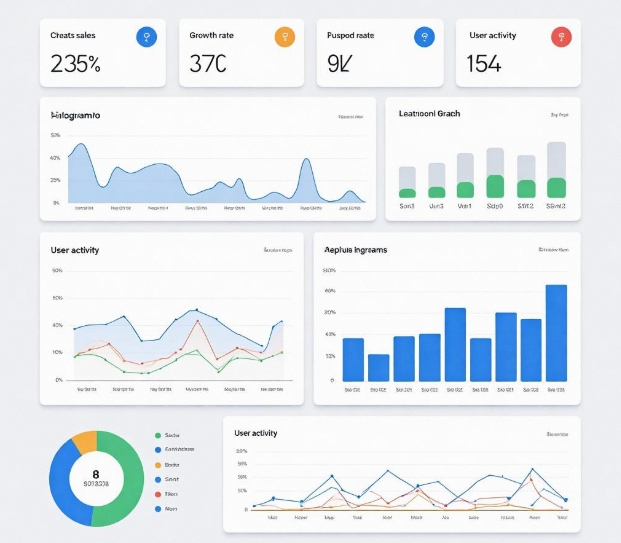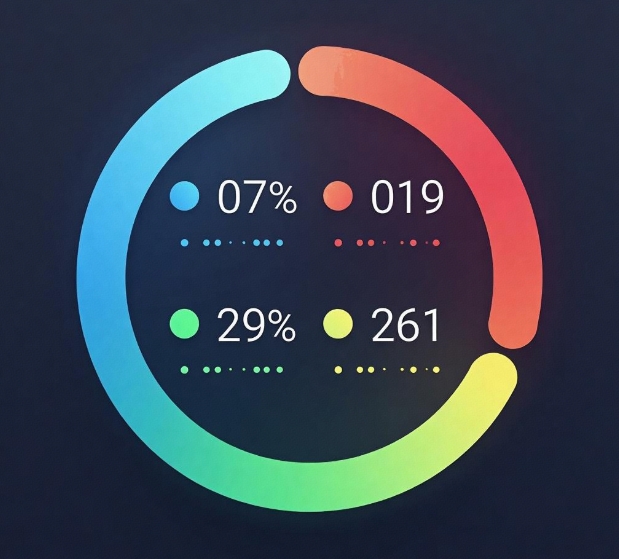Analytics Tools and Data Tracking in APP Development
- latest articles
- 1.DApp Development & Customization: Merging Diverse Market Needs with User Experience 2.Analysis of the Core Technical System in DApp Project Development 3.How to achieve cross-chain interoperability in Web3 projects? 4.How does the tokenization of points reconstruct the e-commerce ecosystem? 5.How to Set and Track Data Metrics for a Points Mall? 6.What is DApp Development? Core Concepts and Technical Analysis 7.Inventory of commonly used Web3 development tools and usage tips 8.Development of a Distribution System Integrated with Social E-commerce 9.Six Key Steps for Businesses to Build a Points Mall System 10.What is DApp Development? A Comprehensive Guide from Concept to Implementation
- Popular Articles
- 1.Future Trends and Technology Predictions for APP Development in 2025 2.Analysis of the DeFi Ecosystem: How Developers Can Participate in Decentralized Finance Innovation 3.From Zero to One: How PI Mall Revolutionizes the Traditional E-commerce Model 4.DAPP Development | Best Practices for Professional Customization and Rapid Launch 5.Recommended by the Web3 developer community: the most noteworthy forums and resources 6.From Cloud Computing to Computing Power Leasing: Building a Flexible and Scalable Computing Resource Platform 7.How to Develop a Successful Douyin Mini Program: Technical Architecture and Best Practices 8.Shared Bike System APP: The Convenient Choice in the Era of Smart Travel 9.How to Create a Successful Dating App: From Needs Analysis to User Experience Design 10.From Design to Development: The Complete Process of Bringing an APP Idea to Life
With the widespread adoption of smartphones, mobile applications (apps) have become an indispensable part of modern life. Whether for socializing, entertainment, shopping, work, or study, apps play a crucial role. As market competition intensifies, optimizing app performance, enhancing user experience, and increasing user retention have become core concerns for every development team. To achieve these goals, analytical tools and data tracking technologies are particularly important.
In the app development process, data tracking and analysis are used to gain deep insights into user behavior, optimize product features, improve app retention and conversion rates, and enhance profitability. Through effective analytical tools, developers can not only identify issues within the product but also accurately pinpoint user needs. This article will explore the commonly used analytical tools and data tracking techniques in app development and analyze their roles and significance in the development process.
I. Data Tracking Needs in App Development
Data tracking refers to the collection of data during app usage through various methods and technologies, followed by analysis and interpretation to provide developers with feedback on app usage. This data typically includes user behavior data, application performance data, and user feedback data. Why is data tracking necessary in app development?
User Behavior Analysis: By tracking user behavior, developers can understand specific user actions within the app, such as which buttons were clicked, which pages were viewed, how long users stayed, and which tasks were completed. This information helps developers assess which features are popular and which are overlooked, providing data support for feature optimization and iteration.
User Retention and Engagement Analysis: User retention and engagement rates are key indicators of an app's success. Data tracking tools help developers analyze the behavioral characteristics of different user groups, identify reasons for churn, and formulate effective user retention strategies.
Performance Optimization: App performance directly impacts user experience. Through data tracking, developers can promptly identify issues such as lagging or crashes during app usage and perform targeted optimizations to improve app stability and responsiveness.
Conversion Rate Analysis: For commercial apps, conversion rates are critical metrics for measuring revenue. Data tracking helps developers analyze the entire user journey from registration to payment and from browsing to purchase, identifying low-conversion stages and making corresponding optimizations.
Personalized Recommendations: By analyzing user data, developers can provide personalized content or features for each user, thereby enhancing user experience and increasing user retention.
II. Common Analytical Tools in App Development
In app development, using appropriate analytical tools for data tracking and analysis is crucial. Below are several common analytical tools that play important roles in data collection, processing, and analysis.
1. Google Analytics for Firebase
Firebase is a mobile app development platform launched by Google, and Google Analytics for Firebase is a powerful data analysis tool. It helps developers comprehensively understand user behavior, providing real-time statistics and multi-dimensional user analysis.
Firebase's advantage lies in its seamless integration features. Developers can track app usage in real-time through Firebase, including user engagement, retention rates, and event triggers. With this data, developers can clearly understand which features are popular and which have issues. Additionally, Firebase offers A/B testing functionality, allowing developers to test different app versions and identify the optimal design and features.
2. Mixpanel
Mixpanel is a tool focused on user behavior analysis, helping developers gain deep insights into user behavior paths within the app. Its core features are "event tracking" and "funnel analysis." Through event tracking, developers can understand each step of user actions in the app, while funnel analysis helps identify key stages where users drop off.
Mixpanel also offers powerful data visualization capabilities, presenting analysis results in charts and tables to help developers understand data more intuitively. Additionally, Mixpanel supports real-time push notifications, enabling developers to quickly inform users about new features or issues.
3. Amplitude
Amplitude is a comprehensive product analysis platform, particularly suitable for complex user behavior data analysis. Its core strength lies in its powerful analytical models, helping developers deeply explore user lifecycles, behavior patterns, and preferences.
One of Amplitude's features is its flexible report generation tool. Developers can customize reports based on different needs to display key data metrics. Additionally, Amplitude supports user segmentation analysis, enabling developers to conduct precise marketing and promotion for different user groups.
4. Hotjar
Hotjar is an analysis tool centered on user experience, excelling in heatmap analysis, session recording, and survey feedback. Heatmap analysis helps developers understand user actions on pages, such as clicks, scrolls, and dwell positions, to evaluate the rationality of page layout and design. Session recording captures users' actual operations in the app, helping developers identify confusion and issues during usage.
Hotjar's advantage lies in its intuitive visualization features, helping developers better understand user behavior and pain points. Through Hotjar, developers can deeply uncover issues in user experience, optimize app interaction design, and improve user satisfaction.
5. Flurry Analytics
Flurry Analytics is a free app analysis tool launched by Yahoo, widely used for user behavior analysis in mobile applications. Flurry's features are relatively straightforward, including user analysis, activity analysis, and revenue analysis. It provides real-time app usage data, helping developers understand user engagement, session duration, and usage frequency.
Flurry's standout feature is its powerful market positioning capability. Developers can conduct detailed analysis based on dimensions such as region, device, and operating system, helping them formulate more targeted product strategies for users in different markets.
III. Challenges in Data Tracking and Analysis
Although data tracking and analysis tools provide valuable insights for app development, developers still face several challenges in practical application:
Data Privacy Issues: With the gradual strengthening of privacy protection regulations (such as GDPR and CCPA), developers must comply with relevant laws and regulations during data collection to ensure user data security and privacy are not violated. Therefore, how to collect and use user data while ensuring compliance has become a significant issue for developers.
Data Noise Issues: During data analysis, data noise may arise. Due to the diversity of user behavior or imprecise data collection methods, inaccurate or misleading data may occur. Developers need to use appropriate data cleaning and filtering methods to remove invalid data and ensure the accuracy of analysis results.
Insufficient Data Analysis Capabilities: Although there are many powerful analysis tools, their effectiveness can be significantly reduced if developers lack the necessary analytical skills. To better understand and utilize data, developers need to possess certain statistical knowledge and data analysis capabilities or rely on data science teams for in-depth analysis.
Real-Time Issues: During app operation, developers need to respond promptly to user behavior. However, some analysis tools may have latency issues, leading to delayed data updates. How to achieve real-time data analysis and adjust product strategies in a timely manner is an important consideration for developers.
IV. How to Effectively Use Analytical Tools to Enhance App Performance
To better utilize analytical tools and enhance app performance, developers can take the following measures:
Set Clear Data Analysis Goals: Before using analytical tools, developers need to define their analysis objectives. Is it to optimize user experience? Or to improve conversion rates? Clear goals help developers focus on key information and avoid getting lost during data analysis.
Conduct Regular Data Reviews: Data analysis is not a one-time task. Developers should regularly review analysis results and adjust development and operational strategies based on data changes. This not only helps identify potential issues but also drives continuous app optimization.
A/B Testing: Through A/B testing, developers can test different features and designs in various app versions to identify the most effective solutions. This process allows developers to innovate and optimize without taking significant risks.
Combine User Feedback with Data Analysis: Data analysis provides objective data on user behavior, but users' subjective feelings and feedback are equally important. Developers can collect user feedback through surveys, reviews, and other methods, combining it with data analysis results to form comprehensive improvement strategies.
V. Summary
Analytical tools and data tracking in app development are key means to optimize products, enhance user experience, and achieve business goals. With technological advancements, data analysis tools are becoming increasingly powerful, enabling developers to gain multi-dimensional insights into user behavior and make precise optimization decisions. However, in practical application, developers still face challenges such as data privacy, data noise, and real-time issues. Only by continuously improving data analysis capabilities and rationally utilizing analytical tools can developers truly enhance app performance and strengthen market competitiveness.
-

How to Use App Development to Boost Conversion Rates on E-commerce Platforms
With the widespread adoption of smartphones and the rapid development of mobile ···
-

How APP Development Facilitates Digital Transformation and Innovation
With the rapid advancement of information technology, digital transformation has···
-

App Store Optimization and SEO Strategies in App Development
In today's rapidly evolving mobile internet landscape, apps have become essentia···

 Blockchain
Blockchain












